Eagles are the raptor of choice for imperial powers, spiritual cultures and Royal insignia, throughout human history. So, it’s only prudent to rank them by size so that we can know who’s the best.
While there are a few ways to do this, we’re going to look at “capacity to block out the sun”, commonly known as wingspan.
Since all species have a natural variation, there may be overlap between some of these species, but we’ve tried to rank them in a way that reflects not only the maximum length ever recorded, but the reliable average, too. Here’s our list of the biggest eagles on the planet.
10. Steppe Eagle – 214 cm (7 ft)
Inhabiting the vast open steppes and savannas of Europe and Asia, the Steppe Eagle is known for its migratory behaviour, covering vast distances during its annual journeys.

These birds breed and spends summer at high altitudes, then fly as far as the Middle East and Southern Africa for the summer. Since they avoid water, vast numbers of migrants can be found during migration season, gathered at bottlenecks along the route.
It’s also known for being a monster! This endangered eagle can weigh up to around 5kg, and eats a wide range of foods from termites to ground squirrels. They’re particularly keen on voles and have even been known to make their nests out of the bones of their enemies.
Their wingspan is about 2.6 times greater than the total body length, making them a very wide-looking bird. At just over 2 meters, this bird is an entry-level giant, but still plenty large enough to get you noticed if you walk around in the park with it on your arm. 1
9. Philippine Eagle – 220cm (7 ft 3 in)
If we were ranking by weight, this one would be in third place. Only the harpy eagle and Stellar’s sea eagle are heavier, and a bird with this much power has no trouble killing monkeys and other large forest animals.

Macaques, reptiles and rats are this bird’s primary protein sources, and their respectable power and shaggy mane-like neck feathers make them an iconic species. So much so that they’re the Philippine national bird.
Despite this, they’re critically endangered due to rampant deforestation, which doesn’t show Philippine nationalism in a very good light. 2
8. Imperial Eagles – 2.2 m (7 ft 3 in)
The Eastern Imperial Eagle has a distinctive white patch on its shoulders and is found in various habitats across Eastern Europe and parts of Asia. The Spanish Imperial Eagle is a different species entirely and occupies a different range, but shares the rankings in terms of wingspan.
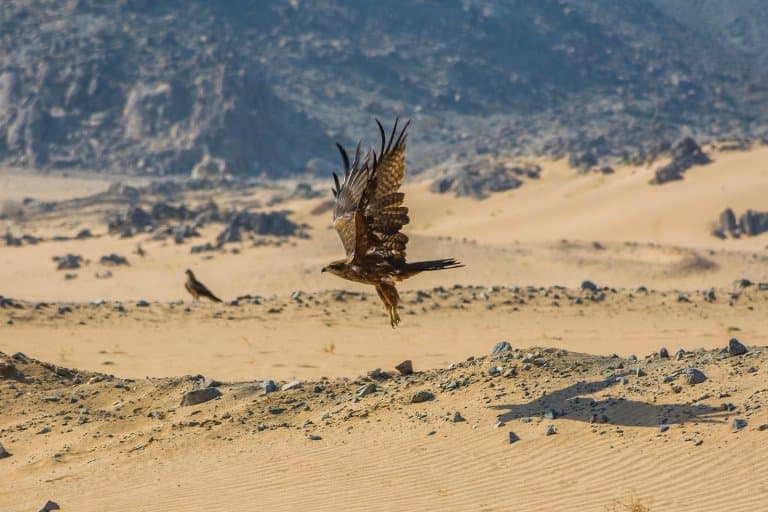
Spanish Imperial eagles have been credited with reducing the Iberian rabbit population, but they’ll also take ducks, pigeons, and even geese.
The Eastern Imperials will feed more on hamsters and lagomorphs. They’ll hang out around Steppe Eagles and have shown to be dominant over them when it comes to hunting, despite only being fractionally larger.
When Winter comes along, both species will hop over to Africa to stay warm.
7. Harpy Eagle – 224 cm (7 ft 4 in)
Known for its massive size and powerful build, the Harpy Eagle is considered one of the largest and strongest eagles in the world. It inhabits the tropical rainforests of Central and South America.
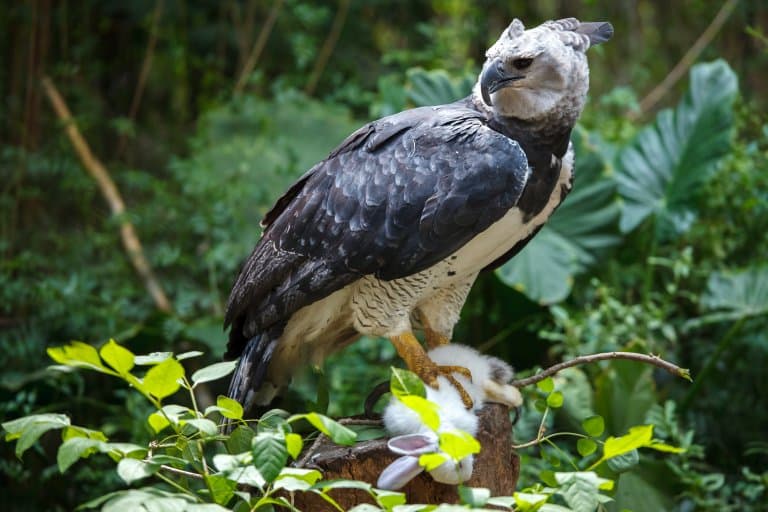
This is one of the eaglest eagles on the list, and a truly impressive-looking animal that specialises in hunting forest mammals.
It’s known for picking off monkeys, which, as monkeys, makes us a little uncomfortable, but they appear to prefer sloths.
They’re named after the Greek monsters and would contend with the Crowned eagle for most eagle-looking eagles. These are heavy predators, packing up to 9kg of flying death behind their talons, and this makes them formidable opponents to the local sloth population. 3
6. Bald Eagle – 2.3 m (7 ft 7 in)
Speaking of Imperial powers, the Bald eagle is the classic symbol of American strength and freedom, though, in classic American pretence, the iconic screech associated with this bird in media is actually the call of the red-tailed hawk.
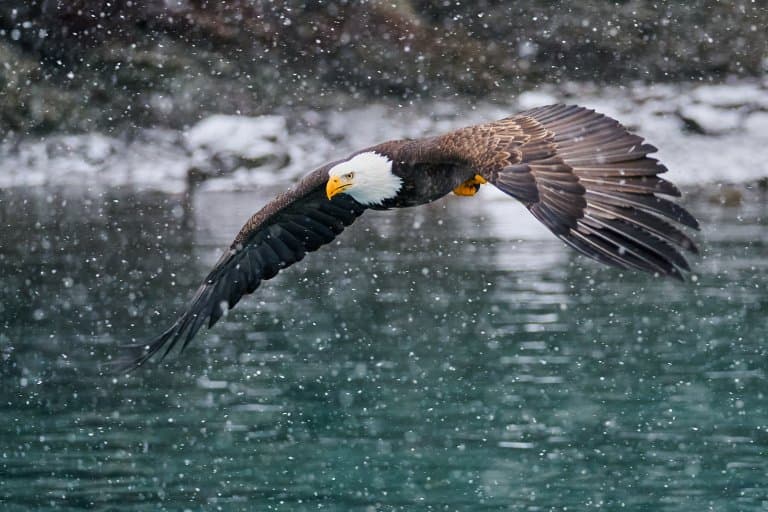
Benjamin Franklin described this animal as “..a bird of bad moral character” and “a rank coward”, on account of it using brute force to steal the hard work of other birds to make a good life for itself while other species perish.
This, ironically, is what makes it an entirely appropriate mascot for the nation.
But the eagle gets a bad rap here. While they do steak kills from other birds, they’re also powerful active predators in their own right and mostly subsist on fish that they catch from the water directly.
These enormous sea eagles also build the largest nest of any North American bird.
5. Golden Eagle – 2.34 m (7 ft 8 in)
Widely distributed across the Northern Hemisphere, the Golden Eagle is renowned for its agility and speed during aerial pursuits. It’s a top predator, capable of taking down large prey on the wing, as well as on the ground or from the water.
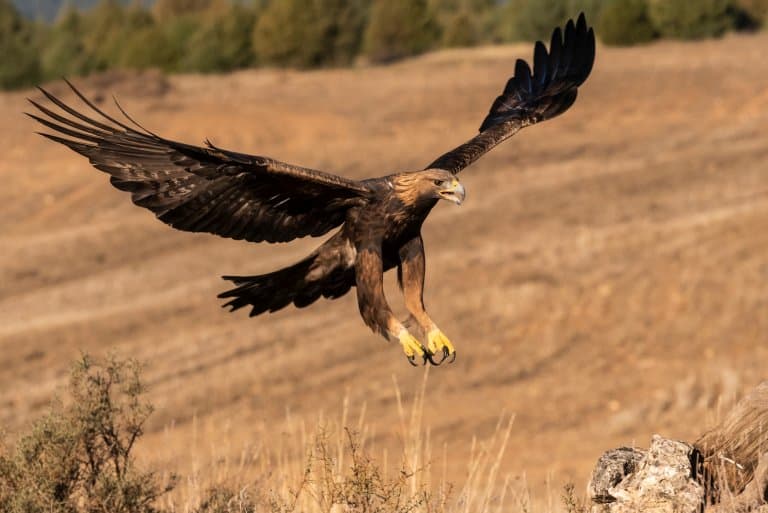
This is the eagle with the widest distribution and an iconic bird from the Northern Hemisphere.
The golden eagle is a very large bird and has enormous talons to match. It’s commonly found taking on rabbits and hares, but can even hunt seals, badgers and coyotes with some success.
These are primarily solitary hunters but have been witnessed teaming up with unrelated individuals to maximise their threat. 4
4. Martial Eagle – 240 cm (7 ft 10 in)
This is another big African booted eagle and another endangered predator. This huge bird is a looker, too, and sports a large feathery crest on its head. Due to its size, it’s a significant member of the community, working as population control for prey and competitor species.
The Martial eagle is big enough to take on powerful Nile monitors, as well as medium-sized mammals and birds. It’s known to kill by stooping at speed, which, at over 6 kg, can hit prey with enough force to kill it outright. 5
3. White-tailed Eagle – 2.45 m (8 ft 0 in)
With a characteristic white tail and a large wingspan, the White-tailed Eagle is a formidable raptor found in Eurasia.
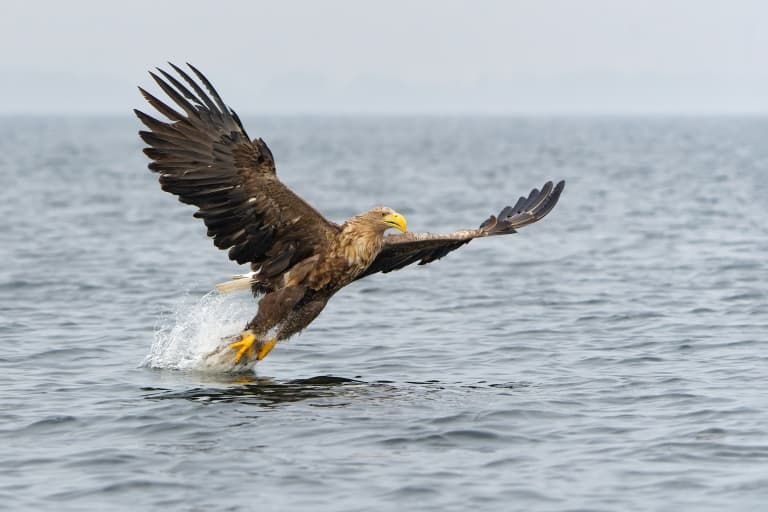
Another sea eagle, it’s known for its exceptional size and hunting abilities and is an accomplished fishing bird. These eagles have been seen plunging into water from 200 m up, slamming into their victim with 5kg of angry bird and carrying off up to 3 kg of fish in one go.
This is a species that engages in the classic eagle mating ritual of locking talons with their mate and cartwheeling through a freefall descent in epic raptor fashion.
They span an enormous range, from Greenland to Japan, and is extremely closely related to the Bald eagle, occupying the equivalent niche in a different range.
2. Steller’s Sea Eagle – 2.50 m (8 ft 2 in)
Native to northeastern Asia, particularly around coastal areas, Steller’s Sea Eagle is recognized for its massive beak and distinctive appearance. It’s often associated with marine environments.

This is a very distinctive bird, not only on account of it being enormous – it’s the heaviest eagle in the world – but also because of its bright yellow beak and legs.
As the name suggests, this is another fish eater who specializes in pink salmon. But they also hunt gulls, which is a valuable public service for coastal peoples trying to sleep or eat chips in peace.
Despite this, local logging is threatening the species with extinction and they’re not vulnerable and decreasing.
1. Wedge-tailed Eagle – 2.84 m (9 ft 4 in)
Australia’s largest bird of prey, the Wedge-tailed Eagle, is an iconic species named for its wedge-shaped tail. It’s no surprise that this bird is culturally significant to Indigenous Australians, as it’s also the likely candidate for the eagle with the biggest wingspan, measuring almost three meters across.

This is a bird big enough to take on young red deer, but as a predator, it isn’t all that picky about what it eats. As a true generalist, it’ll feast on anything it can kill, including invasive rabbits.
Though on average it’s smaller than the Stellar’s sea eagle, this species holds the record for the largest wingspan for an eagle recorded and verified. A female killed in Tasmania in 1931 had a wingspan of 284 cm (9 ft 4 in) across!
While not even close to the heaviest eagle at around 5 kg, the sheer presence of a bid this big is awe-inspiring, and with probably the widest reach of any eagle, it deserves its position at the top of the list. 6
Final Thoughts
That completes our list of the largest eagles in the world. Eagles are incredible birds that maintain a lot of their dinosaur heritage, both in terms of stunning good looks and ferocious flesh-tearing abilities.
Maybe that’s why they’re so popular in human iconography all over the world. Yet, as you can see from the list, many species are in serious danger, threatened with extinction simply because of the widespread deforestation and other habitat loss caused by poorly planned human development.
At least 80% of this deforestation is caused by agriculture. And at least half of that is caused specifically by beef. The inconvenient truth is, that modern over-consumption is the cause of widespread devastation to habitats all over the world, and without the initiative to change course, many incredible animals like these eagles will be soon gone.
Read more about how your personal dietary choices can help protect nature everywhere in this WWF report: Eating for Net Zero.
Fact Sources & References
- “Steppe Eagle“, The Peregrine Fund.
- “Philippine Eagle“, The Peregrine Fund.
- “Harpy Eagle“, San Diego Zoo Wildlife Alliance.
- “Golden Eagle Food Habits“, Avian Report
- “Martial Eagle“, EBird.org.
- S.J. Debus, “Notes on Wedge-Tailed Eagle Behaviour“, ABSA.
